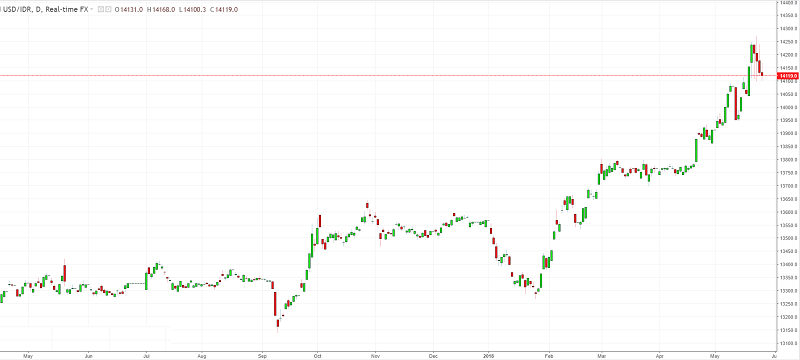A great fall of the Indonesian Rupiah
Up to date, a lot of world economies show a significant rise. Moreover, more and more central banks aim at rate hikes. In the environment of rising global interest rates countries with current account deficits that have relied on fixed income capital inflows to finance those deficits suffers a lot. Indonesia is among those countries.
The Indonesian economy is highly affected by the combination of rising US yields and higher oil prices. The yield on the benchmark 10-year U.S. Treasury note surged above the 3% level and is anticipated to be above this level in the future. Oil is supposed to increase further as there are many encouraging factors for the oil’s rise. It means that the Indonesian economic data will be even weaker. Up to now, a trade deficit in April of $1.6 billion against a forecast surplus of $700 million.
As the Indonesian economy is anticipated to suffer, it’s worth saying about the Indonesian currency that is correlated with the economic growth.
The Indonesian rupiah is among the weakest currencies in Asia for the past five-six months. Up to now, the rupiah is trading near the weakest levels since October 2015. The USD/IDR pair reached the level of 14.235 and tested levels above 14,270. After a great fall, the Indonesian rupiah managed to recover. However, as you can see the USD/IDR pair is still trading at record highs. Up to now, the appreciation of the rupiah is based on the weaker US dollar. However, as the US Federal Reserve is anticipated to continue to raise the interest rate, the rupiah will be under higher pressure.

Analysts predict a higher inflation of emerging markets together with weaker currencies will make central banks to raise interest rates.
That’s already happened to the Indonesian central bank. On May 17, the central bank lifted the interest rate for the first time since November 2014 to support the fragile rupiah. However, the rate hike couldn’t support the Indonesian currency as the hike had already been priced in markets. The central bank aims to use different additional measures to support the falling rupiah. For example, it will conduct foreign exchange swap auctions. Moreover, analysts expect more rate hikes this year.
If the depreciation continues, then inflation and inflation expectations could jump while economic growth would be at risk due to slower household spending.
To conclude, we can say that the Indonesian rupiah is anticipated to suffer as there are important negative factors that are supposed to weight on the currency’s rate. As the US dollar is supposed to continue to rise, the US 10-year Treasury yield is anticipated to be above 3% and oil has a positive forecast, the rupiah will suffer a lot. Additional measures of the Bank Indonesia may slow down the rupiah’s depreciation.